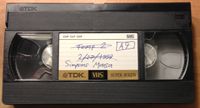VHS
VHS (Video Home System, originally Vertical Helical Scan) was the most used consumer-level video system in the world (at least until DVDs came along), defeating Betamax in the race for worldwide use, mainly because JVC allowed licensing of the technology. Uses vertical helical scan, has limited audio and video bandwidth, signals are stacked as layers on the magnetic tape and is an Color-under (Heterodyne) video-system.
Versions of VHS exist for the NTSC (used in the U.S., Japan, and some other countries) and PAL (used in most of Europe and some other countries) television standards.
The standard calls for a particular recording speed for which tape durations are calibrated (e.g., a T-120 tape stores 120 minutes of recording at standard speed), but most VCRs support nonstandard slower speeds which increase the amount of recording which can be done on a tape at the expense of quality. SP denotes standard play, LP long play (half-speed, so capacities are doubled), and a number of recorders support a still-slower speed designated variously as EP (Extended Play) or SLP (Super Long Play), which gives a recording capacity of three times the standard speed.
